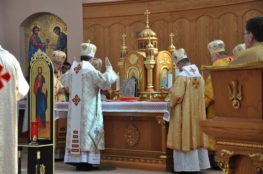Liturgical calendars across rites and usages are such a bother to follow, but knowing something about them helps spare one such terrible embarrassments like wishing an Orthodox friend, “Blessed feast of St. Gregory Palamas!” when, in fact, yesterday was “Triumph of Orthodoxy” Sunday. By the liturgical light of those Eastern Catholics who hold to both the Byzantine Rite and the Gregorian calendar, Palamas was up for praise over the weekend; processing with icons had already come and gone.
Honoring Palamas on the second Sunday of Lent in the Byzantine Rite creates an interesting juxtaposition with the traditional Roman Rite which uses not just Sunday, but the entire weekend, to take special notice of the Transfiguration. Though this seminal event in the earthly mission of our Lord Jesus Christ receives considerably less honor in the Roman Rite on August 6 than it does among the Byzantines, it remains a point of focus on both Ember Saturday and Dominica II in Quadragesima. In happier times, Ember Saturday was a day of ordination; the use of the same Gospel on consecutive days was a sign of continuity between the two Masses. But why that particular reading? Why the Transfiguration? Perhaps it’s because, during this time of penance, we are called to be transfigured, even though few of us will be. Another reason—one which I happen to subscribe to—is because being reminded of the Glory of the Lord and His Divinity is necessary in order to appreciate the full weight of the Cross He will bear in just a few weeks. The Transfigured Christ, the God who cannot suffer and die, will do both. Neither the human heart nor mind can properly mourn the unspeakable injustice of the Passion, but the Church, through her liturgy, offers the means of drawing nearer to that truth so that perhaps we might be instilled with a deeper sense of contrition that it turn flowers full repentance for our role in Christ’s salvific death.
Palamas, whose not uncontroversial spiritual-intellectual relationship to the Light of Mt. Tabor is well known, never had an official Lenten role until the late 14th C. (Prior to that, the second Sunday of Lent belonged to St. Polycarp of Smyrna and, in the old Russian Orthodox rite as reflected in the Chasoslov, appears to have no special commemoration attached to it.) The popular account of Palamas’s place on the Lenten calendar is that he represents a second “Triumph of Orthodoxy”; the first vindicated icons, the second vindicates hesychasm. A slightly broader take on “Palamas Sunday” might go like this. Rather than vindicating one specific form of prayer, the second Sunday of Lent, by Byzantine reckoning, is a reminder of the indispensable need for prayer in order to draw nearer to God in this life and help secure our place with Him in the next. And in particular, during the time of Lent, prayer becomes a great weapon for warding off temptations and persevering in repentance.
Constantly, constantly, constantly I find people, some more well-intentioned than others, clawing at each other over the “best way” to live out the season of Lent. A certain article that made the rounds through social media even went so far as to denigrate Ash Wednesday in favor of Forgiveness Vespers—the Byzantine start to Great Lent which, depending on where you live and what jurisdiction you are under, may or may not come accompanied with the monastic Rite of Forgiveness. And as for Palamas, there are circles where one dares not mention his name lest this Eastern hero receive the stripes of a heretic. And then there’s more: the petty accusations; the quarrels over fasting praxis (or lack thereof); which rite, or use of which rite, or local variant of the dominant use of which rite, contains a “deeper” or “richer” spirituality; and so on, and so forth. What a ghastly spectacle.



